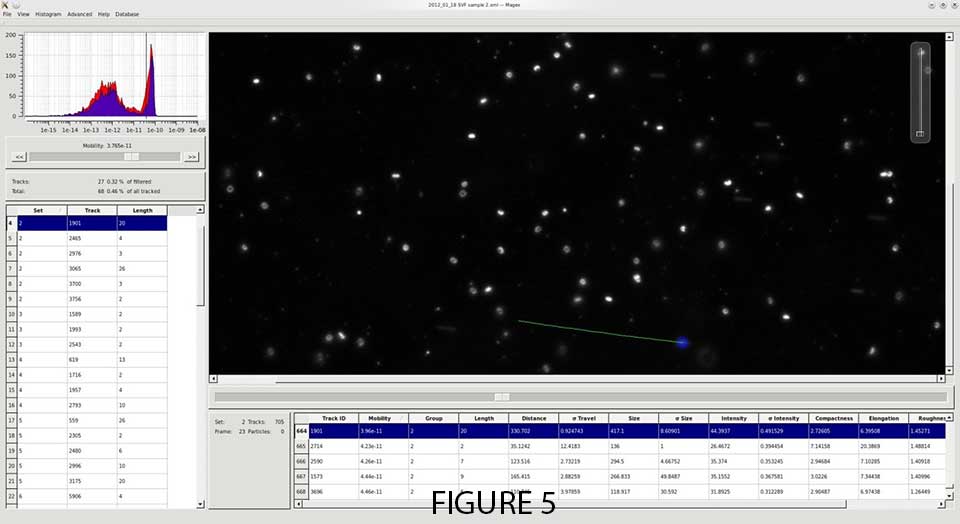The Hyperflux Velocimeter Story
Magnaquant has developed and commercialized particle imaging velocimetry technology developed by IKOTECH, LLC using methods from the Cleveland Clinic Foundation and The Ohio State University for the measurement of motion in a magnetic field. The principal output is magnetophoretic mobility, or velocity per unit magnetic force. From this value it is possible to determine magnetic susceptibility on a single-particle basis, to predict particle velocity in any magnetic field and gradient, and to predict the motion within separation devices of living biological cells labeled with paramagnetic beads.
Operating the Hyperflux Velocimeter
A small sample of particles or cells suspended in a liquid (Figure 1) enters the unique stopped-flow sample cell (Figure 2). These are the components of the integrated, user-friendly Hyperflux Velocimeter (Figure 3) with its unique long-working-distance dark-field microscope and special magnetic gradient that propels particles or cells at constant velocity in the stopped-flow sample cell. All operations are controlled by software using a mouse and screen command menus.



The operator of the Hyperflux Velocimeter can view all of the images created by the high-definition video camera and stored in memory (Figure 4), while the Hyperflux software calculates and displays a histogram of the mobilities of the particles whose velocities were measured frame-to-frame (Figure 4, upper left).

An “instant replay” of any experiment can be performed by the operator. For example, an individual magnetically labeled cell in a mixture can be tracked across the screen using a slide bar while its properties are highlighted in a list-mode table that reveals more than 20 parameters describing the “event” (Figure 5).

The Hyperflux Velocimeter provides printable magnetophoretic mobility histograms from the recorded data files for a mixture of three types of particles, for example (Figure 6), and these data files can be exported for display using commercial software used in flow cytometry including two-parameter displays (Figure 7).


The histograms and plots are smooth, because the Hyperflux Velocimeter analyzes some 50,000 events in a typical measurement. This is achieved by three unique software packages consisting of:
IKOVision™
IKOVision is a real time image capturing microscopy package that serves as the backbone of the data acquisition phase of the Hyperflux process. A sophisticated high-resolution camera is calibrated to the needs of each experiment, capturing motion images of the target material for data analysis. Any number of experimental runs can be produced during this process, each with varying statistics and frame rate options, allowing for sophisticated data analysis.
Cytotest™
Cytotest is the data processing arm of the Hyperflux process. Experiments captured by IKOVision are processed by Cytotest’s sophisticated image processing engine to produce high-quality particle tracking data sets. Operator selected gating parameters enable a high-quality culling process to be applied to the experimental data using pre-set limits or taking advantage of the unique capabilities of the human eye. Once particle selection is complete, the tracking process traces each particle over the duration of the stored video record and outputs and stores a CSV formatted data set for analysis by Magex or for export to other analysis packages.
Magex™
Magex is a sophisticated data analysis tool made available at no additional charge to Hyperflux customers. Track-by-track and frame-by-frame analysis of all Cytotest produced data enable the operator to directly observe particle movement through the re-played experimental run (Figure 5). Per frame fluidic particle measurements include Average, Median & Standard Deviations for many particle properties, and direct particle tracking enables determination of additional information such as sedimentation rate, track linearity and cell size-related properties.
